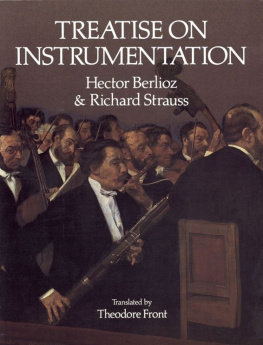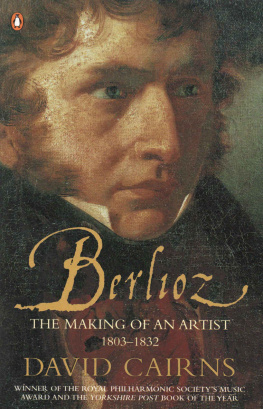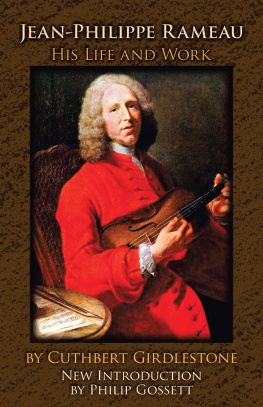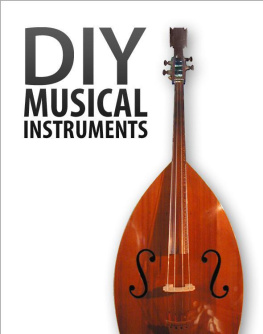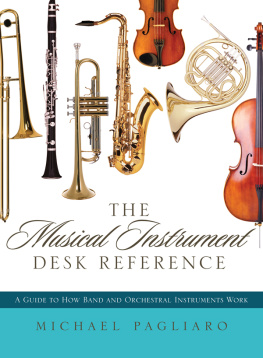TREATISE ON
INSTRUMENTATION
H ECTOR B ERLIOZ
&
R ICHARD S TRAUSS
Translated by Theodore Front

D OVER P UBLICATIONS , I NC. , New York
This Dover edition, first published in 1991, is an unabridged republication of the edition originally published by Edwin F. Kalmus, New York, 1948.
Library of Congress Cataloging-in-Publication Data
Berlioz, Hector, 18031869.
[Grand trait dinstrumentation et dorchestration modernes. English]
Treatise on instrumentation / Hector Berlioz & Richard Strauss; translated by Theodore Front.
p. cm.
Translation of: Grand trait dinstrumentation et dorchestration modernes.
Reprint. Originally published: New York : E. F. Kalmus, c1948. Including Berlioz Essay on conducting.
Includes index.
ISBN -13: 978-0-486-26903-0 (pbk.)
ISBN -10: 0-486-26903-5 (pbk.)
1. Instrumentation and orchestration. I. Strauss, Richard, 18641949. II. Title.
MT70.B4813 1991
781.374dc20
91-24083
CIP
MN
Manufactured in the United States by Courier Corporation
26903507
www.doverpublications.com
CONTENTS
WIND INSTRUMENTS OF WOOD
with Mouthpiece
FOREWORD
When I was asked by the publishers to enlarge and revise the Treatise on Instrumentation by Hector Berlioz, I thought at first that the masterwork of the great Frenchman did not need such help to be even today a source of enjoyment and stimulation for all musicians. It appeared to me complete in itself and full of ingenious visions, whose realization by Richard Wagner is obvious to every connoisseur.
Upon closer study, however, I could not help noticing the gaps in this work, completed in the middle of the last century. I became aware of the danger that important parts of Berlioz work might be considered obsolete and that its lasting value might therefore be overlooked, especially since many other excellent books had developed the subject in the meantime with scientific accuracy (particularly the textbook on instrumentation by the outstanding Belgian authority, Gevaert).
Berlioz was the first to arrange and organize this complicated subject with the supreme industry of a collector. Yet the everlasting value of his work lies in the fact that he not only treated questions of mechanics, but stressed above all the esthetic aspects of orchestral technique. These permanent qualities in the work and its prophetic power, which in a few lines often gives the careful reader a vision of the whole Wagner, may justify this revision. To keep Berlioz work alive even for the superficial reader, it was necessary to supplement technical details and to point out new achievements, especially in Wagners work.
The respect for Berlioz completely unified masterwork demanded that nothing be changed in his text (with the sole exception of the chapter on the organ, which was partly revised and enlarged by Prof. Ph. Wolfrum in accordance with latest developments). My additions are indicated by an undulating line at the side of the text. There is always an abundance of material for musical examples; hence I have avoided important and interesting examples which were quoted by Gevaert. Gevaerts book contains so much worth reading concerning the technique and acoustics of instruments that I should urgently recommend its study in addition to Berlioz work.
__________
In the art of instrumentation, as in other arts, the question of theoretical books is highly problematic. I claim that a musician with talent for composition, who plays the violin or some wind instrument in an orchestra, will have more skill in instrumentation (without any knowledge of its theory) than the equally gifted pianist or music critic who has diligently studied textbooks, but has never come closer to orchestral instruments than the first row of a concert hall.
Therefore, if the student wants to achieve more in the art of instrumentation than just writing a few pleasant-sounding pieces (excellently scored, as our critics would call them), and if he has no opportunity to conduct an orchestra and be in daily contact with its magic powers, then he should not only study the scores of the great masters, but above all ask instrumentalists of all kinds to familiarize him with the exact technique of their instruments and with the timbre of their registers. He should, so to speak, try to find out the secrets of the orchestra tuning-room. There are improvements which an inventive player may have discovered for his mouthpiece, for the arrangement of the valves, for other details in the construction or the material of his instrument, technical tricks, devised in an idle hour for the players own amusement. All this may open unexpected vistas to a creator in search of new forms of expression for new ideas. It may be more valuable for progress than any treatise which is primarily based on the achievements of the past.
Thus, the practical instrumentalist, through his skill, stimulates the composer to new ideas. Great ideas, on the other hand, which at first do not seem feasible, gradually lift the ambitious instrumentalist to their level. They have had the greatest influence on progress in the construction of instruments, on improvements in their technique, and on the enrichment of their expressive possibilities.
__________
The development of the orchestra until the appearance of Berlioz is sufficiently known and need not detain us here too long. I should like to refer the reader to Richard Wagners magnificent interpretations in his writings, especially in Opera and Drama. It would not be appropriate to try to cover here in a few lines a great chapter in the history of music and to show in detail and with all its fine articulations an organic development which was influenced by thousands of seeds, stimuli, mistakes and successes. All I can venture to give here is a brief, compressed survey. I trust the sympathetic reader will understand my intention: not to offer an esthetic system, cleanly divided into separate categories like so many drawers, but simply to develop certain important points, leaving it to the educated reader to fill in the connecting details with the help of his own knowledge and of his feelings. With this reservation, I should like to follow the two main roads of orchestral development from Handel, Gluck and Haydn to Wagner. I might be permitted to call them in brief the symphonic (polyphonic) and the dramatic (homophonic) roads.
The origin of the symphonic orchestra is to be found mainly in Haydns and Mozarts string quartets (as well as in Bachs organ fugues). The symphonic works of these two masters reveal in their style, in their themes, melodies and figurations the character of the string quartet with all its polyphonic possibilities. One might almost call them string quartets with obbligato wood-wind and noise instruments to reinforce the tutti (French horns, trumpets, kettledrums) .
In spite of the greater number of wind instruments used in his Fifth and Ninth Symphonies, even Beethoven cannot hide the mark of chamber music. In Beethoven, more than in Haydn and Mozart, the spirit of the piano injects its characteristic elementsthe same spirit which later completely dominates Schumanns and Brahms orchestral works (unfortunately, not always to their advantage or to the listeners enjoyment). Only Liszt with his instinct for tone colors succeeded in filling this spirit of the piano in the orchestra with new poetic life.
The beautiful melodic contours of the four equally important parts in the classical string quartet attained their highest freedom, worthy of Bachs choral polyphony, in Beethovens last ten quartets. There is none of this freedom in Beethovens nine symphonies. But Wagner found in it the style for his Tristan and Meistersinger orchestra; he owes to it the unheard-of, miraculous sounds of his string quintet.
Next page
